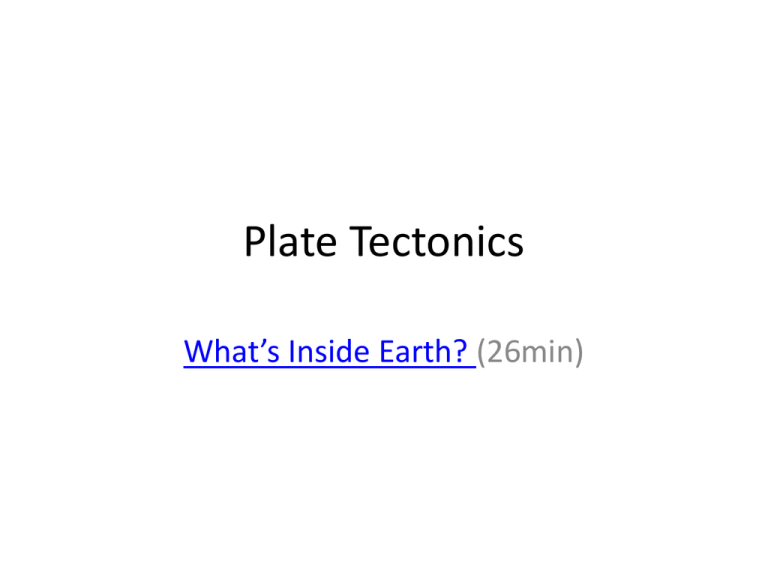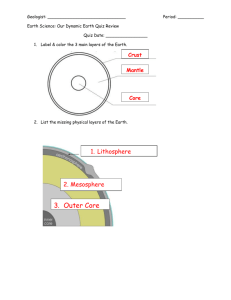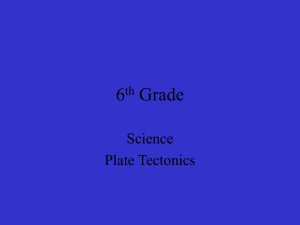Plate Tectonics
advertisement

Plate Tectonics What’s Inside Earth? (26min) Earth’s Layers • Earth is described by the many different layers that make it up: – Outer Layers: • Atmosphere • Hydrosphere • Biosphere – Inner Layers: • Lithosphere • Mantle • Core Inner Layers • The inner layers of Earth are separated into three different regions: – Lithosphere – Consists of the crust and upper mantle – Mantle - Consists of the asthenosphere and mesosphere – Core - Consists of the outer core and inner core The Lithosphere • The lithosphere is the layer of solid rock that forms Earth’s outer surface; dry land & oceans – Very thin: 5-50km thick • 2 Layers: 1. Oceanic Crust • Crust beneath the ocean 2. Continental Crust • Crust that forms the continents. Oceanic Crust Lithosphere Continental Crust The Mantle • Earth’s largest layer • 2 Layers: 1. Asthenosphere • • Soft and bendable Asthenes = Greek for “weak” 2. Mesosphere • Solid rock below the asthenosphere. The Core • 2 parts: 1. Outer Core • Liquid – molten metal (iron & nickel) 2. Inner Core • Solid metal (iron & nickel) • Both Inner and Outer cores make up 1/3 of Earth’s mass but only 15% of its volume. Earth’s Continents • Earth has 7 continents, great landmasses surrounded by water. – Have these landmasses always been in their current location or have they moved throughout history? Drifting Continents • 1910, German scientist Alfred Wegener was curious about the relationship of the continents. – Formed a hypothesis that Earth’s continents have moved. – He began to study: • The landforms on Earth • The fossils on different continents Landforms • In looking as Earth’s landmasses he noticed that the continents looked like puzzle pieces that could fit together. • He believed that the continents had once been joined together in a single landmass and had since drifted apart – Pangaea, “all lands”. Permian – 225mya Jurassic – 150mya Triassic – 200mya Cretaceous – 65mya Present Day Fossils • When looking at the locations of fossil remains, Wegener noted that they occurred at locations that would have been connected during Pangaea. Confirming Wegener’s Theory • New technology in the 1950-60’s confirmed Wegener’s theory of Continental Drift – the hypothesis that the continents have slowly moved across Earth’s surface. – Sonar bounces sound waves off underwater objects. • The time it takes for the echo to arrive back indicates the distance to the object. Our Ocean Floor • With the use of sonar we have been able to map the ocean floor. – Oceans cover ¾ of Earth’s surface and we can’t see the bottom of the oceans. Without sonar we would not know how the bottom of the oceans look. • Characteristics of the Ocean Floor: – Mid-Ocean Ridge – Rift Valley – Deep-Ocean Trenches Mid-Ocean Ridge • The mid-ocean ridge is an under water mountain range that extends into all of Earth’s oceans. – Over 50,000km long Mid-Ocean Ridge • A valley runs the length of the mid-ocean ridge, right down its center = Rift Valley. – Twice as deep as the Grand Canyon. Sea-Floor Spreading • The ocean floor moves like a conveyor belt, carrying the continents. – Molten material rises from the mid-ocean ridge, pushing older rock to both sides and creating new ocean floor. Subduction • The ocean floor does not just keep getting wider and wider. Instead it plunges into deep underwater canyons called deep-ocean trenches – Subduction Zones. – The oceanic crust is more dense than the continental crust. When the two meet the oceanic crust sinks back into the mantle. Subduction Lithospheric Plates • Earth’s lithosphere is not a solid outer crust but cracked or broken into several pieces - Plates. • The Theory of Plate Tectonics states that pieces of Earth’s lithosphere are in constant, slow motion, driven by convection currents in the mantle. – No plate can budge without affecting the other plates surrounding it; plates collide, pull apart or grind past each other. • Links the ideas of continental drift and ocean floor spreading. Earth’s Lithospheric Plates Plate Boundaries • Plate boundaries are where two plates meet. • Depending on the direction the plates are moving you can have three different types of plate boundaries: 1. Transform – sliding past 2. Divergent – moving apart 3. Convergent – moving together Identifying Plate Boundaries • Put the letter of the correct answer in the space provided: A. C 1. Transform _____ B. _____ A 2. Divergent _____ B 3. Convergent C. Transform Boundary • Plates sliding past one another, in opposite directions – Earthquakes often occur here. • Ex. San Andreas in, California Divergent Boundary • Plates moving apart • Oceanic spreading centers – Mid-Atlantic ridge • Rift Valleys – on land – Great Rift Valley in East Africa. Convergent Boundary Moving together – The density of the plates determines which one comes out on top: 1. Oceanic vs. Continental Subduction Convergent Boundary 2. Oceanic vs. Oceanic – Both oceanic crusts sink forming volcanic island arc Convergent Boundary 3. Continental vs. Continental – Land masses fuse together – Uplift and folding of land – Major mountain ranges • Himalayas









